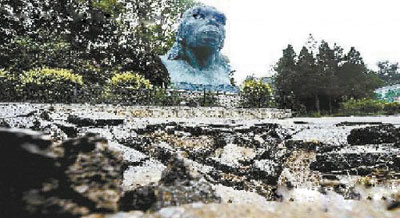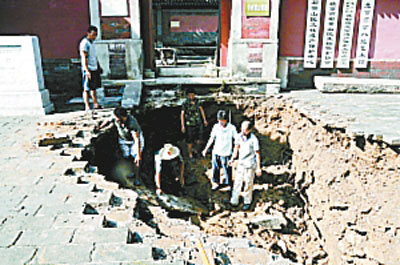|

ABOUT 160 unmovable cultural relics in Beijing were damaged during the storm July 21, when the heaviest rains in 60 years left 77 dead, the Beijing cultural heritage bureau said last week.
Urgent repair measures are needed to preserve some of Beijing’s cultural relics in the wake of the storm, said Kong Fanzhi, chief of the bureau.
An initial investigation showed that the 160 cultural relics, mostly located among 210,000 square meters of the city’s suburbs, saw varying degrees of damage. Direct economic losses totaled more than 800 million yuan (US$125 million).
“Rain accumulated in the courtyards of some heritage sites, such as Baita Temple in Xicheng District and Guozijian (Imperial College) in Dongcheng District. Water reached more than one meter deep in some areas,” Kong said.
All flood water was drained by July 22 morning.
The Forbidden City was not affected by the rainstorm due to its existing drainage system.
Other heritage sites were not so lucky, said Kong, as the rain caused parts of structures to collapse. Nearly five meters of the courtyard wall at Dajue Temple in Haidian District crumbled July 21.
Cultural relics at the district level in Fangshan, Fengtai and Shijingshan districts sustained more serious damage, and more than 80 cultural relics in Fangshan District faced threats such as collapse and saturation, the bureau said.
Major unmovable cultural relics in Beijing, including six world cultural heritages, did not suffer much in the storm, and no large-scale collapses have been found among the stretches of the Great Wall located in Beijing, it said.
Still this should remind people to urgently protect Beijing’s relics, Kong said.

An employee, surnamed Hao, who works at Badachu Park, Shijingshan District, said that parts of the main constructions in the park collapsed due to the rainstorm.
“I just checked the sixth site in the park and found some collapse on the main construction. Some roads were damaged due to landslides,” Hao said.
The park reopened to the public July 22, and the damaged areas were closed off.
Kong said the general principle is to do repairs if problems are found.
“We won’t take steps to reinforce these constructions to resist natural disasters, since they are relics, not normal constructions. If we rebuild the main buildings or install a modern water drainage system, they will no longer be relics,” Kong said.
(SD-Agencies)
|

